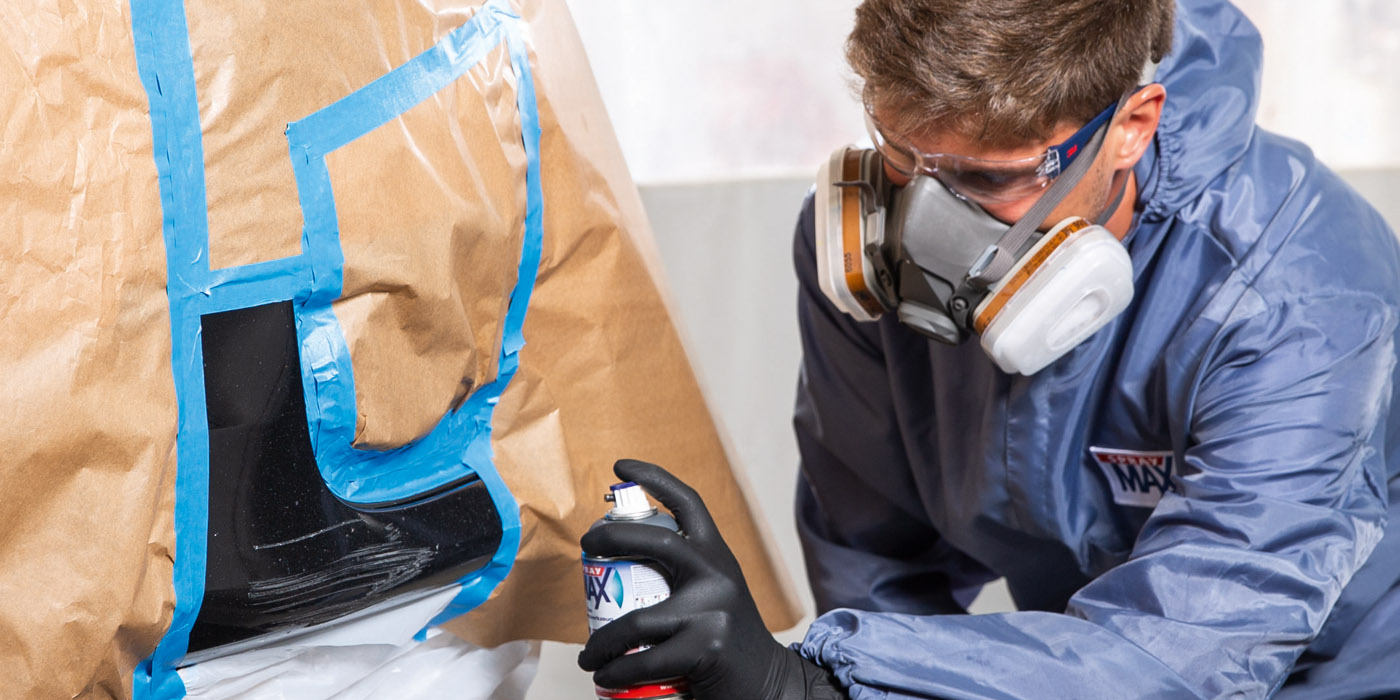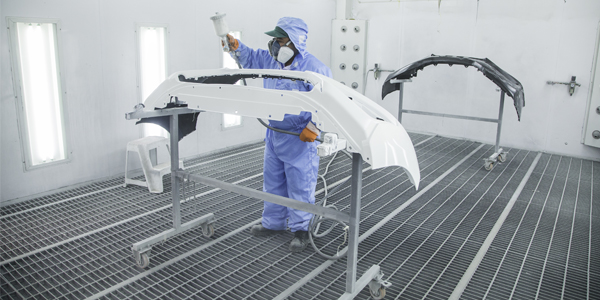Becoming the industry’s “gun of choice,” HVLP gravity-feed spray guns save you money and do most of the work for you.
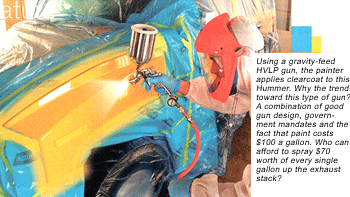
I recently visited autobody paint shops in far corners of the country. Every single one was using gravity-feed spray guns, most of them high volume, low-pressure (HVLP). How did this style of spray gun become the industry-wide default setting – and why should you consider using gravity-feed spray guns if you aren’t already?
Three Ways to Build a Gun
As you’ll recall, there are three ways to build a spray gun:
1. Siphon feed.
2. Pressure feed.
3. Gravity feed.
Yet gravity feed rules the roost.
Let’s take a look at all three …
-
- Siphon feed – The industry default gun for decades was siphon (or suction) feed. These spray guns had a cup, typically 32 ounce, mounted on the bottom of the gun body. Handy because you could set the gun down on any flat surface.
The paint was drawn up to the air cap from the very bottom of the long pickup tube by creating a partial vacuum directly in front of the hole in the fluid tip. By crossing two air streams at a precise angle, the 14.7 PSI that surrounds us all (atmospheric pressure) was lowered by the tiny vacuum. Because the pressure inside the vacuum was less, the paint was pushed up to the fluid tip by atmospheric pressure. This style of spray gun has a vent hole in the cup top to allow more 14.7-PSI air inside and worked well enough to paint virtually every car repaired in America for six decades.
- Pressure feed – Pressure-feed spray guns have no vent hole in the attached cup (or remote pressure pot) because the paint is pushed up to the fluid tip by compressed air. Two air lines power pressure-feed guns – one goes to the gun’s regular air inlet, and the other pressurizes the paint container. Typically used to paint semi trucks and other large equipment, pressure feed allows the painter to hold the gun at any angle, even upside down. Plus the bigger the pot, the longer you can paint without refilling.
- Gravity feed – Gravity-feed spray guns have been around since at least the 1940s and were the standard in Europe many years before they caught on here. With the cup mounted on the top side of the gun body, the paint will run down (gravity!) to the fluid tip. This will deliver paint into the atomizing airflow better than sucking it up, but not as well as pushing it up.
The Cons of Siphon & Pressure Feed
So what’s the problem with using siphon- and pressure-feed equipment in an autobody paint shop?
Suction-feed spray guns create a turbulent cloud of air in front of the gun that blows much of the atomized paint off target. Crossing the two streams of air creates a partial vacuum inside the tiny triangle in front of the fluid tip where they cross each other.
Once past the space directly in front of the fluid tip, however, the crossed air streams bump into each other and fly off at all angles. As a result, the paint gets caught in these sideways drafts, and less than half of the paint in the cup ends up on the car; the other half is wasted as overspray.
It’s the poor transfer efficiency (how much paint ends up on the target) that caused the industry to move away from these style guns.
Pressure-feed equipment has much better transfer efficiency because the paint is delivered under pressure and no breezy and turbulent vacuum is required. The problem with pressure-feed guns is excessive cleanup.
The pressure-feed guns most suited to autobody repair have either a 2-quart remote cup with 4-foot or 6-foot fluid hoses connecting the pot to the gun, or they have an attached cup with a check valve. In a fleet paint shop, they’d have 25 feet or 50 feet of fluid hose and a 21/2 or 5-gallon pot.
In the case of the remote cup, the 4-foot hose and the 1/2-gallon pot need to be thoroughly cleaned out after every use. In autobody – where as many as 75 percent of all repairs can be completed with less than one pint of color – that takes lots of cleanup thinner and lots of non-productive labor time.
When the pressure pot is mounted directly on the gun body, the pot is pressurized by a very short hose that runs from the butt of the gun to the attached cup. But any pressure vessel requires a check value.
A check valve is simply a one-way valve that allows paint to pass into the pot but not back out. When the check valve is located inside an attached 1-quart cup, the sloshing action as the gun is waved back and forth splashes lots of paint into the check valve and frequently clogs it. Once clogged, the paint flow quits mid-job, and the painter must stop and clean it out. While 2-quart and 5-gallon pots have check valves too, they don’t get waved around as much!
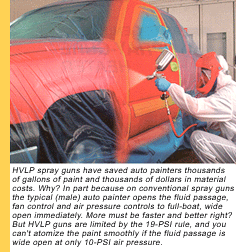
Why Gravity Feed?
Gravity feed offers the best of both – the gun doesn’t have a check valve and doesn’t need the big suck.
The paint is delivered to the front of the gun without the necessity of siphon feed’s turbulent partial vacuum because it simply falls down into the airflow. In fact, air caps on all three styles have some element of siphoning action to make sure the paint is pulled out of the gun into the atomizing air. Suction-feed guns just require much more to pull the paint all the way up the long pickup tube.
But gravity feed didn’t immediately become the gun of choice.
In the late 1980s, many autobody painters in this country objected to the gravity-feed cup-on-top gun design. They couldn’t set down the gun on any flat surface because the paint would pour out the vent hole in the top of the cup. Gravity-feed guns necessitate hooks or stands to hold the gun when not in use – hardly an insurmountable issue.
In the early days, the other often-heard objection was that they couldn’t see around the cup. Hello! Good painters don’t stand directly behind any style of spray gun. How would they see the paint hit the surface and know it was flowing correctly unless they viewed it at an angle? (FYI: At least one gun manufacturer now offers a swivel fitting to position the top cup conveniently when spraying odd areas.)
Despite these painter objections, gravity-feed guns continued to grow in popularity.
Also contributing to the near universal adoption of gravity-feed spray guns was the concern regarding air pollution. In an effort to clean up air quality, many heavily populated areas of the country passed legislation that mandated spray equipment with higher transfer efficiencies. The reasoning was if more sprayed material went on the target, less went up in the atmosphere as overspray. They were right of course.
Enter HVLP
HVLP technology improves the transfer efficiency (TE) of all three types of spray guns. HVLP works in part because low atomizing pressure (10 PSI or less measured at the air cap) leaves larger paint droplets. Bigger, heavier paint drops tend to carry directly to the target. Higher air pressures can break the paint into such tiny, weightless drops that they’re easily blown off target.
Additionally, the narrow spray parameters demanded by HVLP keep the painter from getting way out of whack. For example, you can’t open the fluid wide open on many HVLP guns and still break it up at 10-PSI maximum air cap pressure. You have to jack up the PSI to break up the larger volume of paint, which causes more overspray and blows the paint off target.
Remember always that gun design, paint viscosity, target size and air pressure all play a role in good transfer efficiency. But none of them are as important as the operator. Trained painters can get great TE from any equipment. Poor painters can’t get good TE with any style or design.
Adding HVLP technology to all three gun designs will improve their TE. The old rule of thumb was you could make a 50 percent improvement in TE by applying HVLP air cap technology and design to any type of spray gun.
If this were so and suction feed had a normal TE of 30 percent, an HVLP version would yield 45 percent TE. Regular pressure feed might produce 50 percent TE, and an HVLP pressure feed would hit 75 percent TE. If conventional gravity feed could deliver 40 percent TE, it would yield 60 percent with HVLP.
All of this is theoretical conjecture. It’s possible to have a poor pressure HVLP design and yield less than 65 percent TE, while a good gravity-feed design can deliver much more than 65 percent TE. Siphon feed HVLP remains a poor choice simply because of the turbulent air required to get the paint pulled up to the fluid tip.
So how did the industry land on HVLP gravity feed? A combination of good gun design, regulatory mandate and the fact that paint costs $100 a gallon. Even if you aren’t in a regulated area and can choose any type of spray gun you like, it hurts to spray $70 worth of every single gallon up the exhaust stack. Good transfer efficiency saves money, period.
Maintaining Your Gravity-Feed Gun
What kinds of things can you do to keep your gravity spray gun operating at peak efficiency? 4 Clean it – Something I noticed on my recent travels is that many more painters are keeping their guns scrupulously clean and maintained.
I used to froth when a painter would drop off his crusty, caked, stuck-shut spray gun for rebuild and repair. “Hey,” I wanted to scream, “if you don’t paint, you don’t get paid and your family doesn’t eat. Clean the thing! Your living depends on it!”
What I saw in almost every shop this year were clean guns. Sometimes even a clean paint room! These folks figured out that if you spend hundreds of dollars for a nice gun and depend on painting hundreds of hours each month to earn a living, you better keep the gun working right. There are enough other problems to fill a painter’s day than re-doing work because the gun choked.
Cleaning HVLP gravity-feed guns today requires a combination of hand and machine cleaning. Most shops I visited used at least one air-powered automatic gun washer. One shop used three. Unfortunately a couple of shops still did their entire gun cleaning by hand. I agree that some hand cleaning is necessary, but get the bulk of the work done without your labor time.
Gun washers work best if they employ special gun-cleaning solvent. Many shops use recycled lacquer thinner to clean spray equipment. While this is cheap and way better than dumping it down the sewer drain, it doesn’t do a very good job dissolving the dried paint and clear. Simply leaving the gun in the running washer longer with cheap thinner doesn’t help much and also washes away the lubrication and dries the packings.
Special gun-cleaning solvents are mixes of mid-temp lacquer thinner (pretty decent solvency) and methyl ethyl ketone (MEK), a very strong solvent. MEK is such a strong solvent that if used to thin primer, it’d no doubt show every sand scratch ever.
Many shops used two gun washers, one with cheap stuff to wash off the worst of the paint resin and another with better solvent to clean the small holes. What small holes?
Today’s sophisticated air caps and fluid tips often have many tiny siphon, atomization and pattern containment holes. These are especially easily filled by the new super high solids clears. And since the resin is perfectly clear, a tiny air hole can look clean because light shows through it but still be restricted or plugged.
And the new HS clears dry so hard that they have to be gouged out of the holes with metal picks (rather than with a wooden probe similar to a toothpick, which was the standard way to clean air caps for years). Be cautious not to twist the metal pick like a screw because it’ll quickly enlarge or elongate the precision holes in a brass or aluminum air cap. HVLP guns are very susceptible to small changes either restricting or enlarging the many and specific holes in their caps and nozzles. Be careful, but also be sure to get them perfectly clean.
Plastic squirt bottles loaded with clean-up solvent save time every day. If you don’t have at least two on your paint bench right now, get ’em.
Many shops also are using some sort of disposable cup liner to minimize cleanup and labor time – labor time being far and away the more expensive. Clean-up thinner is 50 or 60 cents a quart; labor time is 60 or 70 cents a minute! Any tools that save time so you can paint cars instead of clean equipment are well worth the price. Don’t look at what the cups or liners cost. Look at how quickly you can be ready to spray the next product.
Tear down the gun – At least once a month or possibly once a week, depending on how many cars you spray, tear down the gun to the basic components. Remove the air cap every time, but only remove the fluid tip occasionally.
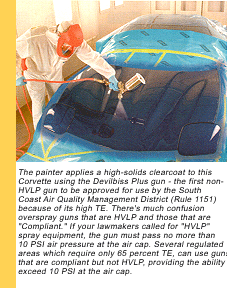
One way to keep the gun operating longer is to use the cover plugs that came with the gun or the washer. Capping the air inlet will keep harsh solvent out of the gun’s innards.
Employ as many little brushes as necessary to clean your gun quickly. Need one with stiff bristles and a right-hand bend? Make or buy exactly the brushes that will clean the gun fast. Maybe a special bracket inside the gun washer will hold the air cap directly in front of the solvent flow. Know anybody who could fabricate one? Several shops I visited had unique widgets to facilitate their gun maintenance.
On your monthly mini-rebuild, be sure to lubricate the moving parts with spray gun lube – typically some sort of vegetable oil because it won’t cause fisheyes or destroy packings.
Make sure to reinstall the fluid tip to the correct tightness. One of the most common gun problems is the spit-spit-spit noise when air is leaking into the gun head. The most likely place for that leak to occur is the joint between the gun body and the fluid tip. Some guns require Teflon tape on their threads; others would clog hopelessly if you used tape. Make sure you know what your model requires.
Many painters keep a cheap 3/8-inch ratchet and the correct 6-point socket on the paint bench. It takes some serious torque on most guns to get a good seal between the tip and body. Be especially careful of the gun when the air cap is removed and the fluid tip is exposed. Even a slight nick from contact with the edge of the paint bench can ruin a fluid tip. Have the tools and jigs to get your fluid tip back on tightly and quickly.
- Be prepared for gun setup variables – Having an air pressure gauge and regulator mounted on or in the spray gun helps to get color match dialed in quickly. Many snazzy basecoat colors are very susceptible to small changes in spray pressure. Being able to duplicate and adjust the exact spray pressure will ensure blendable matches in less time.
Some new guns even have digital pressure gauges built in, saving the extra weight and length an external regulator requires. Either way, you need some reliable way to manage the air pressure.
HVLP guns don’t have the loud hiss and visible kick that conventional siphon guns have. Yet I still meet people who pull the trigger on their HVLP and, judging by the noise and feel, set the spray pressure. Yeah, right.
Set the pressure on the gun with the trigger pulled and air flowing through the gun. What the regulator on the wall says doesn’t matter. It’s what the one on the gun says. Or, in regulated areas, what the air cap pressure is. You need a special test cap to determine what maximum inlet pressure will yield 10 PSI or less at the cap. Test cap and gauges are about a $60-to-$80 item.
- Use the correct fluid nozzle diameter – Having the correct fluid nozzle diameter (and needle to match) is essential to good results. Depending on what type (clear, color, primer) of material and what brand of spray gun, you’ll get best results with a very specific tip-needle-air cap combination.
So do you need a 1.2 mm or a 1.4 mm? What about for primer? A 1.6 mm or 2.1 mm might be just right.
How will you know where to start? With the paint manufacturer and spray gun catalog. Gun manufacturers make equipment that will do a great job with any brand of paint. But the correct size (diameter of hole) isn’t the same for all brands. Paint Brand A may say to use 1.2 mm for basecoat, while Paint Brand B says 1.4 mm.
Ask everyone who might help. Your jobber sales person and the factory rep for both the gun and the paint will have good input. Listen to their advice. In many parts of the country, it’s still a slow sell to move to smaller diameter fluid tips.
Why? It just seems wrong. If labor time is the most expensive thing (and it is), wouldn’t more paint through a bigger hole be better?
Not with high solids paints and low air pressure. You can dump so much paint though a big fluid tip that you can’t get enough air volume or pressure to atomize it all. In general, go smaller for better finish quality.
If you get all the variables right, your industry-default gravity-feed spray gun will do most of the work. Although a good painter can overcome a poorly functioning spray gun with skill, technique and another coat, it’s much better to get it right the first time and spray the next coat on the next car.
Writer Mark Clark, owner of Professional PBE Systems in Waterloo, Iowa, is a well-known industry speaker and consultant. He’s been a contributing editor to BodyShop Business since 1988.
Photos courtesy of ITW Automotive Refinishing.










